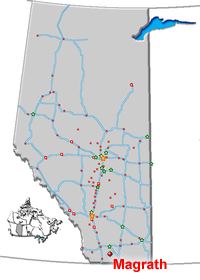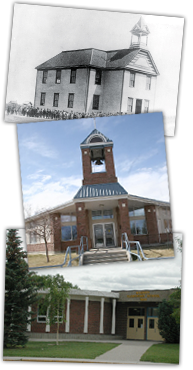Magrath, Alberta
 Students
look to the past in developing 21st Century skills
Students
look to the past in developing 21st Century skills
by: Lorena Rodgers
Grade 6 students at MES are delving into local history and government and finding some very interesting things.
Through the Galileo Educational Network, the students are involved in a project of learning about their community's municipal bylaws.
Galileo's representative has been working with Ryan Blackmore's Grade 6 class and is impressed with the student's initiative and enthusiasm in the project. "The kids are looking at bylaws and how they apply, how they have changed and what old ones still exist," says Judy Martin, Galileo Education Mentor." The class is so willing to do it, to put their town up on the map." The students have been reviewing some old bylaws, and finding some that catch their interest. They found that a bylaw was passed 21 Oct. 1907 that says it is illegal to ride or drive across Pothole Bridge faster than you can walk across, with a penalty of up to 10 cents. "At first, the kids say that's stupid," says Blackmore, "but then they start thinking about it, asking questions like: What was the bridge made of then? What happened in history? Why would they have to have this rule? Then they come up with good, possible explanations; legitimate points to explain things that seem strange now."
As well as reviewing our bylaws, the students have also produced a 30-second commercial about municipal bylaws and written a one-page history of Magrath that will appear on the Galileo Bylaws's website.
Blackmore says his students have been so interested in the project that with Martin's guidance, the students themselves came up with the grading criteria for their commercial. "They understood everything it needed - colour, music, the visuals, the information. It would have taken me an hour to write up a rubric for the assignment and they had it done in 10 minutes."
Blackmore says this has been a great refresher for the students on
their municipal government section in Social Studies, but that they
have learned much more from the project. "They're using 21st Century
skills -how do we use technology? They can go on the Internet now and  search
out things. They need to be critical thinkers and be good at problem
solving," Blackmore says. The students have also taken an interest
in their community and its history through the project. "They're
learning about things that would have been overlooked,"Blackmore
says. "They understand the bylaws very well - the process with
presentation, three readings, discussion -, but now it means something
to them."
search
out things. They need to be critical thinkers and be good at problem
solving," Blackmore says. The students have also taken an interest
in their community and its history through the project. "They're
learning about things that would have been overlooked,"Blackmore
says. "They understand the bylaws very well - the process with
presentation, three readings, discussion -, but now it means something
to them."
Galileo Education Network information states part of its purpose is "to engage students in authentic, real work that reflects the work that an adult at work or in the community might tackle. Schools ought to be communities of robust inquiry that strive to foster intellectual habits of thought, meaning-making and discourse in all students. Not only that, but schools ought to be communities where students come to do rich, engaging work - work that inspires, develops insight and stirs the imagination."
Blackmore says his students have grown - not only with what they've learned, but also through how they learn. "The kids have done a phenomenal job," Blackmore adds. "They're learning and they're excited about it. It makes it interesting for them."
